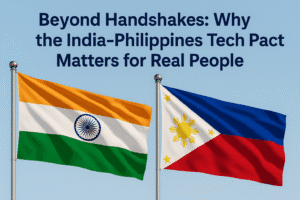Beyond Handshakes: Why the India-Philippines Tech Pact Matters for Real People
India and the Philippines have launched a focused 2025-2028 science pact, prioritizing action over ambition. The collaboration zeroes in on geospatial tech for disaster resilience – leveraging India’s mapping expertise to save Filipino lives during typhoons and floods – and sustainable ocean management to protect vital coastal resources. Crucially, it builds lasting human capacity through scientist exchanges and joint training, moving beyond symbolic agreements.
The deal pushes for market-ready innovations, encouraging joint R&D in areas like climate-smart crops and island energy solutions. This South-South partnership strengthens ASEAN ties, offering scalable models for regional challenges. Structured oversight via regular joint committees aims to turn eight broad sectors (AI, health, space etc.) into measurable outcomes. Ultimately, success hinges on tangible benefits: lives saved from disasters, seas sustained for livelihoods, and opportunities unlocked through shared knowledge.

Beyond Handshakes: Why the India-Philippines Tech Pact Matters for Real People
The recent signing of a renewed science and technology agreement between India and the Philippines isn’t just diplomatic paperwork. It’s a strategic pivot with tangible implications for citizens facing shared challenges like climate disasters, food security, and sustainable growth. Here’s what makes this collaboration significant:
- Moving from Vision to Action on Critical Fronts: While broad cooperation areas aren’t new, the laser focus on geospatial technology and the blue economy is a game-changer. Both nations are archipelagic and highly vulnerable:
- Disaster Resilience: India’s advanced geospatial capabilities (like its National Geospatial Policy 2022 and ambitious 2030 digital elevation model goals) directly address the Philippines’ urgent need for hyper-accurate flood, landslide, and storm surge modeling. This isn’t abstract science; it means better early warnings, smarter evacuation routes, and saving lives during increasingly frequent typhoons.
- Sustainable Ocean Wealth: The “blue economy” focus tackles overfishing, marine pollution, and coastal erosion. Indian expertise in satellite monitoring and sustainable aquaculture can empower Philippine coastal communities to manage fragile resources, boosting livelihoods while protecting ecosystems vital for both nations.
- Building Capacity, Not Just Exchanging Ideas: The agreement explicitly prioritizes people-to-people links – fellowships, scientist exchanges, joint training. This is crucial for long-term impact. The Philippines gains access to India’s vast network of technical institutions (like ISRO, NIOT, DBT labs), while Indian researchers gain invaluable field experience in unique Philippine marine and volcanic environments. This builds lasting institutional bridges, moving beyond one-off projects.
- Targeting Innovation with Market Potential: Encouraging joint R&D for commercially viable technologies signals a pragmatic shift. Imagine Filipino agricultural biotech researchers collaborating with Indian AI experts to develop drought-resistant rice strains suited to both climates, or joint ventures creating affordable energy storage solutions for remote islands. This moves research from the lab towards solving real market needs and creating economic opportunity.
- A Model for South-South Cooperation: This partnership transcends bilateral benefits. As Dr. Singh noted, it strengthens the India-ASEAN framework. Success stories in areas like disaster tech or ocean science developed here could offer scalable solutions for other vulnerable Southeast Asian and Indian Ocean rim nations, fostering regional resilience and shifting the narrative on technology transfer from North-South to collaborative South-South innovation.
- Institutionalizing Success: The commitment to regular Joint Committee meetings and clear provisions on funding, IP rights, and workshops shows both nations are serious about implementation. This structure provides accountability and a mechanism to adapt to emerging challenges – vital for translating the ambitious 8-sector plan (AI, health, space, etc.) into concrete results.
The Human Impact:
This isn’t just about governments and scientists. The real value lies in potential outcomes:
- Coastal Communities: Fishermen using data-driven sustainable practices; villages protected by better disaster maps.
- Farmers: Access to climate-resilient crops developed through joint biotech research.
- Urban Populations: Smarter cities using shared AI and geospatial insights for resource management.
- Researchers & Entrepreneurs: New avenues for innovation, funding, and market access.
The 2025-2028 Programme of Cooperation is more than a renewal; it’s a focused, implementation-driven roadmap. By prioritizing urgent shared vulnerabilities (geospatial disasters, ocean sustainability), embedding capacity building, fostering market-ready innovation, and establishing robust oversight, India and the Philippines are positioning their S&T partnership as a crucial engine for tangible societal benefit and regional resilience. The success of this collaboration will be measured not just in signed papers, but in lives saved, resources sustained, and opportunities created for their people.
You must be logged in to post a comment.